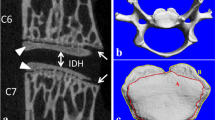Abstract
The aim of this study was to distinguish the characteristics of intervertebral disc degeneration (IVDD) originating from mechanics imbalance, biology disruption, and their communion, and to develop a composite IVDD model by ovariectomy combined with lumbar facetectomy for mimicking elderly IVDD with osteoporosis and lumbar spinal instability. Mice were randomly divided into four groups and subjected to sham surgery (CON), ovariectomy (OVX), facetectomy (mechanical instability, INS) or their combination (COM), respectively. Radiographical (n = 4) and histological changes (n = 8) of L4/5 spinal segments were analyzed. Tartrate-resistant acid phosphatase (TRAP) staining was conducted to detect osteoclasts, and expression of osterix (OSX), type I collagen (Col I), type II collagen (Col II) and vascular endothelial growth factor (VEGF) were evaluated by immunochemistry. OVX affected the body's metabolism but INS did not, as the body weight increased and uterus weight decreased in OVX and COM mice compared to CON and INS mice. OVX, INS, and COM caused IVDD in various degrees at 12 weeks after surgery. However, the major pathogeneses of OVX- and INS-induced IVDD were different, which focused on endplate (EP) remodeling and annulus fibrosus (AF) collapse, respectively. OVX induced osteopenia of vertebra. In contrast, INS promoted the stress-adaptive increase of subchondral bone trabeculae. The COM produced a reproducible severe IVDD model with characteristics of sparse vertebral trabeculae, cartilaginous EP ossification, subchondral bone sclerosis, fibrous matrix disorder, angiogenesis, disc stiffness, as well as space fusion. Additionally, all groups had elevated bone and cartilage turnover compared with CON group, as the quantity of trap + osteoclasts and the osteogenic OSX expression increased in these groups. Likewise, the VEGF expression levels were similar, accompanied by the altered matrix expression of disc, including the changed distribution and contents of Col II and Col I. The findings suggested that the composite mouse model to some extent could effectively mimic the interactions of biology and mechanics engaged in the onset and natural course of IVDD, which would be more compatible with the IVDD of elderly with vertebral osteoporosis and spinal instability and benefit to further clarify the complicated mechanobiological environment of elderly IVDD progression.





Similar content being viewed by others
Availability of Data and Materials
The authors are committed to sharing their data, publishing the data, and making available the molecular resources described in this publication to the scientific community.
Abbreviations
- IVDD:
-
Intervertebral disc degeneration
- CON:
-
Control
- OVX:
-
Ovariectomy
- INS:
-
Instability
- COM:
-
Combination
- TRAP:
-
Tartrate-resistant acid phosphatase
- OSX:
-
Osterix
- Col:
-
Collagen
- VEGF:
-
Vascular endothelial growth factor
- EP:
-
Endplate
- AF:
-
Annulus fibrosus
- NP:
-
Nucleus pulposus
- CT:
-
Computed tomography
- ROI:
-
Region of interest
- BV/TV:
-
Percent bone volume
- BS/TV:
-
Bone surface density
- Tb.N:
-
Trabecular number
- Tb.Th:
-
Trabecular thickness
- Tb.Sp:
-
Trabecular separation
- SMI:
-
Structural model index
- BMDtv:
-
Total volume bone mineral density
- IVD:
-
Intervertebral disc
- SB:
-
Subchondral bone
- Cr:
-
Cranial
- Ca:
-
Caudal
- AOD:
-
Average optical density
References
Izzo R, Popolizio T, D'Aprile P, Muto M (2015) Spinal pain. Eur J Radiol 84:746–756
Choi H, Tessier S, Silagi ES, Kyada R, Yousefi F, Pleshko N, Shapiro IM, Risbud MV (2018) A novel mouse model of intervertebral disc degeneration shows altered cell fate and matrix homeostasis. Matrix Biol 70:102–122
Oichi T, Taniguchi Y, Soma K, Chang SH, Yano F, Tanaka S, Saito T (2018) A mouse intervertebral disc degeneration model by surgically induced instability. Spine (Phila Pa 1976) 43:E557–E564
Norcross JP, Lester GE, Weinhold P, Dahners LE (2003) An in vivo model of degenerative disc disease. J Orthop Res 21:183–188
Manek NJ, MacGregor AJ (2005) Epidemiology of back disorders: prevalence, risk factors, and prognosis. Curr Opin Rheumatol 17:134–140
Dolan P, Luo J, Pollintine P, Landham PR, Stefanakis M, Adams MA (2013) Intervertebral disc decompression following endplate damage: implications for disc degeneration depend on spinal level and age. Spine (Phila Pa 1976) 38:1473–1481
Maerz T, Newton M, Marek AA, Planalp M, Baker K (2018) Dynamic adaptation of vertebral endplate and trabecular bone following annular injury in a rat model of degenerative disc disease. Spine J 18(11):2091–2101
Brinckmann P, Grootenboer H (1991) Change of disc height, radial disc bulge, and intradiscal pressure from discectomy. An in vitro investigation on human lumbar discs. Spine (Phila Pa 1976) 16:641–646
Vergroesen PP, Kingma I, Emanuel KS, Hoogendoorn RJ, Welting TJ, van Royen BJ, van Dieen JH, Smit TH (2015) Mechanics and biology in intervertebral disc degeneration: a vicious circle. osteoarthr cartil 23:1057–1070
Hsieh AH, Twomey JD (2010) Cellular mechanobiology of the intervertebral disc: new directions and approaches. J Biomech 43:137–145
Stefanakis M, Luo J, Pollintine P, Dolan P, Adams MA (2014) ISSLS prize winner: mechanical influences in progressive intervertebral disc degeneration. Spine (Phila Pa 1976) 39:1365–1372
Zhou Z, Tian FM, Wang P, Gou Y, Zhang H, Song HP, Wang WY, Zhang L (2015) Alendronate prevents intervertebral disc degeneration adjacent to a lumbar fusion in ovariectomized rats. Spine (Phila Pa 1976) 40:E1073–E1083
Fukui D, Kawakami M, Cheng K, Murata K, Yamada K, Sato R, Yoshida M, Yamada H, Inoue N, Masuda K (2017) Three-dimensional micro-computed tomography analysis for spinal instability after lumbar facetectomy in the rat. Eur Spine J 26:2014–2020
Karsdal MA, Bay-Jensen AC, Lories RJ, Abramson S, Spector T, Pastoureau P, Christiansen C, Attur M, Henriksen K, Goldring SR, Kraus V (2014) The coupling of bone and cartilage turnover in osteoarthritis: opportunities for bone antiresorptives and anabolics as potential treatments? Ann Rheum Dis 73:336–348
Funck-Brentano T, Cohen-Solal M (2011) Crosstalk between cartilage and bone: when bone cytokines matter. Cytokine Growth Factor Rev 22:91–97
Bellido M, Lugo L, Roman-Blas JA, Castaneda S, Caeiro JR, Dapia S, Calvo E, Largo R, Herrero-Beaumont G (2010) Subchondral bone microstructural damage by increased remodelling aggravates experimental osteoarthritis preceded by osteoporosis. Arthritis Res Ther 12:R152
Holm S, Maroudas A, Urban JP, Selstam G, Nachemson A (1981) Nutrition of the intervertebral disc: solute transport and metabolism. Connect Tissue Res 8:101–119
Polikeit A, Nolte LP, Ferguson SJ (2004) Simulated influence of osteoporosis and disc degeneration on the load transfer in a lumbar functional spinal unit. J Biomech 37:1061–1069
Wang Y (2018) Senile osteoporosis is associated with disc degeneration. Quant Imaging Med Surg 8:551–556
Lou C, Chen HL, Feng XZ, Xiang GH, Zhu SP, Tian NF, Jin YL, Fang MQ, Wang C, Xu HZ (2014) Menopause is associated with lumbar disc degeneration: a review of 4230 intervertebral discs. Climacteric 17:700–704
Wang YX, Griffith JF (2010) Effect of menopause on lumbar disk degeneration: potential etiology. Radiology 257:318–320
Calleja-Agius J, Muscat-Baron Y, Brincat MP (2009) Estrogens and the intervertebral disc. Menopause Int 15:127–130
Ou-Yang L, Lu GM (2015) Dysfunctional microcirculation of the lumbar vertebral marrow prior to the bone loss and intervertebral discal degeneration. Spine (Phila Pa 1976) 40:E593–E600
Luo Y, Li SY, Tian FM, Song HP, Zhang YZ, Zhang L (2018) Effects of human parathyroid hormone 1–34 on bone loss and lumbar intervertebral disc degeneration in ovariectomized rats. Int Orthop 42:1183–1190
Mattei TA (2013) Osteoporosis delays intervertebral disc degeneration by increasing intradiscal diffusive transport of nutrients through both mechanical and vascular pathophysiological pathways. Med Hypotheses 80:582–586
Salo S, Leinonen V, Rikkonen T, Vainio P, Marttila J, Honkanen R, Tuppurainen M, Kroger H, Sirola J (2014) Association between bone mineral density and lumbar disc degeneration. Maturitas 79:449–455
Sun Z, Luo ZJ (2019) Osteoporosis therapies might lead to intervertebral disc degeneration via affecting cartilage endplate. Med Hypotheses 125:5–7
Xiao ZF, He JB, Su GY, Chen MH, Hou Y, Chen SD, Lin DK (2018) Osteoporosis of the vertebra and osteochondral remodeling of the endplate causes intervertebral disc degeneration in ovariectomized mice. Arthritis Res Ther 20:207
Deng M, Griffith JF, Zhu XM, Poon WS, Ahuja AT, Wang YX (2012) Effect of ovariectomy on contrast agent diffusion into lumbar intervertebral disc: a dynamic contrast-enhanced MRI study in female rats. Magn Reson Imaging 30:683–688
Gruber HE, Johnson T, Norton HJ, Hanley EJ (2002) The sand rat model for disc degeneration: radiologic characterization of age-related changes: cross-sectional and prospective analyses. Spine (Phila Pa 1976) 27:230–234
Yurube T, Nishida K, Suzuki T, Kaneyama S, Zhang Z, Kakutani K, Maeno K, Takada T, Fujii M, Kurosaka M, Doita M (2010) Matrix metalloproteinase (MMP)-3 gene up-regulation in a rat tail compression loading-induced disc degeneration model. J Orthop Res 28:1026–1032
Lotz JC (2004) Animal models of intervertebral disc degeneration: lessons learned. Spine (Phila Pa 1976) 29:2742–2750
Bian Q, Jain A, Xu X, Kebaish K, Crane JL, Zhang Z, Wan M, Ma L, Riley LH, Sponseller PD, Guo XE, Lu WW, Wang Y, Cao X (2016) Excessive activation of TGFbeta by spinal instability causes vertebral endplate sclerosis. Sci Rep 6:27093
van der Meulen MC, Huiskes R (2002) Why mechanobiology? A survey article. J Biomech 35:401–414
Zhu J, Tang H, Zhang Z, Zhang Y, Qiu C, Zhang L, Huang P, Li F (2017) Kaempferol slows intervertebral disc degeneration by modifying LPS-induced osteogenesis/adipogenesis imbalance and inflammation response in BMSCs. Int Immunopharmacol 43:236–242
Zhang T, Zhao K, Han W, Yang W, Lu X, Liu Q, Li X, Qian Y (2018) Deguelin inhibits RANKL-induced osteoclastogenesis in vitro and prevents inflammation-mediated bone loss in vivo. J Cell Physiol 234(3):2719–2729
Dubrovsky AM, Lim MJ, Lane NE (2018) Osteoporosis in rheumatic diseases: anti-rheumatic drugs and the skeleton. Calcif Tissue Int 102:607–618
Barth M, Weiss C, Bouma GJ, Bostelmann R, Kursumovic A, Fandino J, Thome C (2018) Endplate changes after lumbar discectomy with and without implantation of an annular closure device. Acta Neurochir (Wien) 160:855–862
Pye SR, Reid DM, Lunt M, Adams JE, Silman AJ, O'Neill TW (2007) Lumbar disc degeneration: association between osteophytes, end-plate sclerosis and disc space narrowing. Ann Rheum Dis 66:330–333
Muraki S, Yamamoto S, Ishibashi H, Horiuchi T, Hosoi T, Orimo H, Nakamura K (2004) Impact of degenerative spinal diseases on bone mineral density of the lumbar spine in elderly women. Osteoporos Int 15:724–728
Binch AL, Cole AA, Breakwell LM, Michael AL, Chiverton N, Cross AK, Le Maitre CL (2014) Expression and regulation of neurotrophic and angiogenic factors during human intervertebral disc degeneration. Arthritis Res Ther 16:416
DeLucca JF, Cortes DH, Jacobs NT, Vresilovic EJ, Duncan RL, Elliott DM (2016) Human cartilage endplate permeability varies with degeneration and intervertebral disc site. J Biomech 49:550–557
Adams MA, Dolan P (2012) Intervertebral disc degeneration: evidence for two distinct phenotypes. J Anat 221:497–506
Adams MA, Dolan P, McNally DS (2009) The internal mechanical functioning of intervertebral discs and articular cartilage, and its relevance to matrix biology. Matrix Biol 28:384–389
Silagi ES, Shapiro IM, Risbud MV (2018) Glycosaminoglycan synthesis in the nucleus pulposus: dysregulation and the pathogenesis of disc degeneration. Matrix Biol 71–72:368–379
Bedore J, Leask A, Seguin CA (2014) Targeting the extracellular matrix: matricellular proteins regulate cell-extracellular matrix communication within distinct niches of the intervertebral disc. Matrix Biol 37:124–130
Kamper M, Hamann N, Prein C, Clausen-Schaumann H, Farkas Z, Aszodi A, Niehoff A, Paulsson M, Zaucke F (2016) Early changes in morphology, bone mineral density and matrix composition of vertebrae lead to disc degeneration in aged collagen IX -/- mice. Matrix Biol 49:132–143
Yang C, Mosler S, Rui H, Baetge B, Notbohm H, Muller PK (1995) Structural and functional implications of age-related abnormal modifications in collagen II from intervertebral disc. Matrix Biol 14:643–651
Acknowledgements
We thank Mr. Yang Fan for helping in micro-CT scanning and analyses, The Laboratory Affiliated to Orthopaedics and Traumatology of Chinese Medicine of Linnan Medical Research Center of Guangzhou University of CM for providing the associated experimental facilities, and Animal Center of Guangzhou University of CM for helping in the implementation of animal experiments.
Funding
This work was supported by the National Natural Science Foundation of China [NSFC, Grant Numbers, 81673992, 81804118] and The Education Department of Guangdong Province [Grant Numbers, A1-AFD018191A117].
Author information
Authors and Affiliations
Contributions
All authors made a substantial contribution to the data analysis and interpretation, drafting of the manuscript and critical revision of the manuscript for important intellectual content. D-k Lin and Z-f Xiao conceived the study and D-k Lin secured the funding; Z-f Xiao, Guo-yi Su and Shu-dong Chen performed experiments; Yu Hou and Bing-de Zhao contributed to data collection and analysis; Zhi-feng Xiao, Jian-bo He, Ji-heng Zhang and Yan-jun Chen drafted the manuscript. All authors gave their final approval of the version to be published.
Corresponding author
Ethics declarations
Conflict of interest
All authors declare that they no conflict of interest.
Human and Animal Rights and Informed Consent
All experimental procedures were approved by the Ethics Committee of Guangzhou University of Chinese Medicine and implemented according to the guidelines and regulations for use and care of animals.
Additional information
Publisher's Note
Springer Nature remains neutral with regard to jurisdictional claims in published maps and institutional affiliations.
Zhi-feng Xiao and Guo-yi Su have contributed equally to this work.
Rights and permissions
About this article
Cite this article
Xiao, Zf., Su, Gy., Hou, Y. et al. Mechanics and Biology Interact in Intervertebral Disc Degeneration: A Novel Composite Mouse Model. Calcif Tissue Int 106, 401–414 (2020). https://doi.org/10.1007/s00223-019-00644-8
Received:
Accepted:
Published:
Issue Date:
DOI: https://doi.org/10.1007/s00223-019-00644-8




